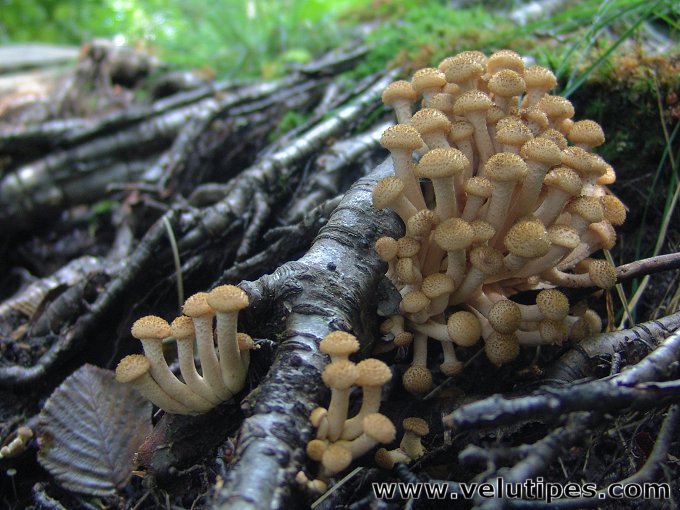
This genome was sequenced as part of the JGI CSP "1000
Fungal Genomes – Deep Sequencing of Ecologically-relevant
Dikarya" project. Within the framework of this project, we are
sequencing keystone lineages of saprophytic, mycorrhizal, and
endophytic fungi that are of special ecological importance. Dozens
of sequenced species were harvested from Long Term Observatories to
serve as the foundation for a reference database for metagenomics
of fungi and for a comprehensive survey of the soil fungal
metatranscriptome.
Armillaria borealis
FPL87.14
Members of the genus Armillaria belong to the Physalacriaceae, a
highly diverse family in the Agaricales containing white rot wood
decayers and devastating tree pathogens. They cause shoestring root
rot, which leads to significant losses in forest areas or woody
plants, including forests, parks or vineyards, among others, mostly
in the temperate zone. The infection is usually characterized by
presence of rhizomorphs and mycelial mats between the bark and
cambium layer of the host root. Rhizomorphs are shoestring-like
multicellular structures, which are analogous to plant roots in
appearance and forage for food by spreading inside the soil.
Armillaria spp. produce macroscopic fruiting bodies that
are edible and known as honey mushrooms. Many existing individuals
of Armillaria are believed to be the largest and oldest terrestrial
organisms known on earth.
We aim to sequence the genomes of several Armillaria
strains representing both aggressive pathogens and white-rot
saprotrophs. This will allow us to gain insights into the evolution
of pathogenicity and the mechanisms of interaction between
Armillaria and their host trees. It will further help in
understanding the biology of these species, including their
strategies for host invasion, for wood decay, and the development
of rhizomorphs and fruiting bodies. We hope these resources will
open the door for developing efficient management strategies for
limiting the spread and damage to forest ecosystems.
Armillaria borealis (Marxm. & Korhonen)1
is confined primarily to Europe. It is widely distributed across
Southern Scandinavia, Northern France, The Netherlands and
Scotland. It was also reported in China, Siberia and on mountains
of Iran2,3,4. A. borealis is a opportunistic
pathogen with a wide host range including coniferous as well as
broadleaved trees. It seems to have pathogenic potential, but
appears most often as a saprotroph towards the already weakened
trees including conifers, wild cherry, and birch.
The 1KFG project is a large collaborative effort aiming for master
publication(s). Please do contact the PI for 1KFG - Deep Sequencing
of Ecologically-relevant Dikarya (Dr. Francis Martin) for
permission prior to the use of any data in publications.
Genome Reference(s)
Sahu N, Indic B, Wong-Bajracharya J, Merényi Z, Ke HM, Ahrendt S, Monk TL, Kocsubé S, Drula E, Lipzen A, Bálint B, Henrissat B, Andreopoulos B, Martin FM, Bugge Harder C, Rigling D, Ford KL, Foster GD, Pangilinan J, Papanicolaou A, Barry K, LaButti K, Virágh M, Koriabine M, Yan M, Riley R, Champramary S, Plett KL, Grigoriev IV, Tsai IJ, Slot J, Sipos G, Plett J, Nagy LG
Vertical and horizontal gene transfer shaped plant colonization and biomass degradation in the fungal genus Armillaria.
Nat Microbiol. 2023 Sep;8(9):1668-1681. doi: 10.1038/s41564-023-01448-1
References
- Marxmuller H. (1982). Étude morphologique des Armillaria ss.str. à anneau. Bulletin de la Société Mycologique de France. 98(1):87-124.
- Qin GF, Zhao J and Korhonen K. (2007). A study on intersterility groups of Armillaria in China. Mycologia 99:430-441.
- Pavlov IN. (2015). Biotic and abiotic factors as causes of coniferous forests dieback in Siberia and Far East. Contemp. Probl. Ecol. 8:440-456.
- Asef MR, Goltapeh EM and Alizadeh A. (2003). Identification of Armillaria biological species in Iran. Fungal Divers. 14:51-60.
